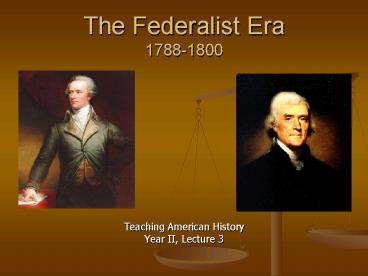The Federalist Era 17881800 - PowerPoint PPT Presentation
1 / 18
Title:
The Federalist Era 17881800
Description:
Triple threat: British in Canada, Spanish in AL/MS, Indians in Ohio ... Can you separate trade and politics? The Birth of Political Parties. in the 1790s ... – PowerPoint PPT presentation
Number of Views:35
Avg rating:3.0/5.0
Title: The Federalist Era 17881800
1
The Federalist Era1788-1800
- Teaching American History
- Year II, Lecture 3
2
Major Themes
- Hamiltons three-point program for harnessing the
state to the economy, and the conflict this
brought about - Washingtons troubles with Indians, Whiskey
Rebels, and European wars - Political parties, their characteristics, and
their emergence in the context of domestic and
international crises - The wild and crazy election of 1800
3
Hamiltons Fiscal Program
- Debt elimination and assumption
- The national debt
- Report on Public Credit
- The debate over Hamiltons program
- Compromise Pass Hamiltons plan, move capitol to
VA/MD
4
Hamiltons Fiscal Program
- The national bank
- Will stabilize and expand currency, capital
- The Constitutional issue strict vs. loose
constructionism - Washington supports Hamiltons position
5
Hamiltons Fiscal Program
- Tariffs and Manufacturing
- Report on Manufacturers (1791)
- Protective tariffs rejected by Congress
- Hamiltons legacy
6
The Washington Administration Crises Foreign and
Domestic
- Managing the western territory
- Triple threat British in Canada, Spanish in
AL/MS, Indians in Ohio - U.S. Indian policy contradictory
- As established under ordinances of 1785 and 1787
- Sham treaties and other problems
- Intercourse Act (1790)
7
The Washington Administration Crises Foreign and
Domestic
- Settlement pressures lead to war
- Initial victories by Indian confederation under
Little Turtle - Battle of Fallen Timbers (1793) and Treaty of
Greenville (1795)
8
The Washington Administration Crises Foreign and
Domestic
- Diplomacy and Trade
- War between Britain and France disrupts trade
- Jays Treaty (1795) makes concessions to British
at French expense - Pinckneys Treaty (1795) cedes southwest to U.S.
- Deepens political divisions
9
The Washington Administration Crises Foreign and
Domestic
- Whiskey Rebellion
- Hamiltons excise tax to retire national debt
- Class and sectional conflict result
- Rebellion suppressed by Washington
10
Washingtons Farewell Address
- Beware of political parties and entangling
alliances with European powers - Can you separate trade and politics?
11
The Birth of Political Parties in the 1790s
- Despite warnings and fears, parties formed
- Initially parties develop around key leaders
- Full-blown political organizations by 1796
12
Hamiltonians/Federalists
- Hamiltons economic program
- Retire debt with Whiskey Tax
- National bank
- Protective tariffs
- Strong central government for strong national
economy - Tied national government to monied class
13
Jeffersonians/Democratic Republicans (later
Democrats)
- Vision of yeoman, agrarian republic
- Small federal government, geographic expansion,
common people
14
Parties by 1796
- Federalists
- Vision trade and manufacturing
- Merchants, artisans, commercial interests
- Strong central government
- Pro-British
- Northeast
- View of other mobocracy
- Democratic-Republicans
- Vision agrarian republic
- Farmers
- Limited central government
- Pro-French
- South and west
- View of other monarchy/aristocracy
15
Election of 1796
16
The Crisis of the Adams Presidency, 1796-1800
- Rooted in fears of France
- French Revolution spinning out of control
- French anger over Jays Treaty
- XYZ Affair and fears of French invasion
17
The Crisis of the Adams Presidency, 1796-1800
- Alien and Sedition Acts (1798)
- Alien act targeted French radicals
- Sedition Act outlawed criticism of government
- Response Kentucky and Virginia Resolves
18
Election of 1800 and Triumph of
Democratic-Republicans
- The Election of 1800
- The electoral system
- Jefferson wins popular vote by huge margin,
electoral vote by very narrow margin - Electoral snafu throws election into House, where
Federalists have a field day - 35 votes later, Hamilton swings election to
Jefferson, a fateful and perhaps fatal decision - The End of the Federalist Era



























![Era University - [EU], Lucknow PowerPoint PPT Presentation](https://s3.amazonaws.com/images.powershow.com/9678343.th0.jpg?_=20211029093)
![get⚡[PDF]❤ The Anti-Federalist Papers (Dover Thrift Editions: American History) PowerPoint PPT Presentation](https://s3.amazonaws.com/images.powershow.com/10043939.th0.jpg?_=20240531069)


